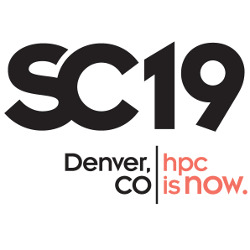
More than 13,000 have flocked to the Colorado Convention Center in Denver to hear more than 1,100 presenters at the SC19 supercomputing conference.
The event is both conference and exhibition, with many companies coming to show off their supercomputing-related wares and spread their company-imprinted t-shirts, pens, and other tchotchkes that keep the companies on attendees' minds when they return to their universities and corporate facilities.
Today began with the bestowing of some awards. ACM President Cherry M. Pancake and IEEE Computer Society executive committee member Hironori Kasahara presented framed award certificates to:
- Geoffrey Charles Fox of Indiana University Bloomington, the recipient of the 2019 ACM/IEEE CS Ken Kennedy Award for "foundational contributions to parallel computing methodology, algorithms and software, data analysis, and their interface with broad classes of applications, and mentoring students at minority-serving institutions."
- Alan Edelman, who leads the Julia laboratory in the Massachusetts Institute of Technology's Computer Science and Artificial Intelligence Laboratory, and is chief scientist at Julia Computing. Edelman received the 2019 IEEE Computer Society Sidney Fernbach Award "for outstanding breakthroughs in high performance computing, linear algebra, and computational science and for to the Julia programming language."
- David B. Kirk, former chief scientist and vice president of architecture at Nvidia. He received the 2019 IEEE Computer Society Seymour Cray Computer Engineering Award "for outstanding leadership in developing GPU computing and in engendering its rise to the mainstream of HPC."
The award presentations were followed by the SC19 Keynote Address on the impact of high-performance computing on space exploration. Steven Squyres, James A. Weeks Professor of Physical Sciences at Cornell University and principal investigator for the science payload on the Mars Exploration Rover Project, discussed some of the issues he and his colleagues ran into and overcame in developing and sending the robotic rovers "Spirit" and "Opportunity" to investigate Mars. As an example, he discussed how the software that allows the robots to drive around on the Martian surface had not been written at the time the first robot was rocketed into space; he and his colleagues spent the next five months writing and testing that software, before sending it to the robot, which had another two months before it arrived on Mars.
Asked after his presentation about how much of the technologies developed for space exploration can accelerate technology development down here on Earth, Squyres said, not so much, as the technologies they develop are highly specialized. As an example, he described spending three years developing a lightweight, low-power rock drill that can penetrate stones on the Martian surface to a depth of less than an inch in three hours, adding "it's a great thing to have on a solar-powered vehicle, but nobody's going to buy it at Home Depot."
SC19 continues through Friday, Nov. 22.
Lawrence M. Fisher is Senior Editor/News for ACM Magazines.



Join the Discussion (0)
Become a Member or Sign In to Post a Comment